





The Mediterranean climate is a marginal climate for growing palms though there are literally hundreds of species that can be grown in such climates (comparable to the drier USDA zones 9b-10a climatic zones- eg. southern France and Italy, Southern California, Sydney Australia etc.). These are all basically mild, minimally humid to nearly desert-like subtropical climates in which most truly tropical palms cannot survive, but ones where killing frosts are infrequent. Most landscapers and growers are well aware of the common and hardy palms that grow in these climates, and make good use of them frequently. However, there are other excellent choices that are less well known. And that is the point of this article, to give the reader 20 more excellent palms for their climate that maybe not too many others have and that can be potentially great landscape additions to their yards or businesses.
Palms that are commonly grown in such climates include Chamaerops (Mediterranean Fan palm), Trachycarpus fortunei (Chinese Windmill palm), Butia capitata (Pindo or Jelly palm), Syagrus romanzoffiana (Queen palm), Washingtonias (Mexican and California Fan Palms), Phoenix species (many), Archontophoenix cunninghamiana (King Palm), Brahea armata (Mexican Blue Fan Palm) and many of the other Braheas, Dypsis decaryi (Triangle Palm), Howea forsteriana (Kentia Palm), Livistona chinensis (Chinese Fan Palm), Rhapis palms (Lady palms), Sabal palmetto, Ravenea rivularis (Majesty Palm), Jubaea (Chilean Wine Palm) and now even Bismarckias and Wodyetias (Foxtail palms) are becoming common place. The following will be a discussion of some OTHER good but less well known choices for a marginal Mediterranean climate, such as that found in southern California. These palms will be listed in alphabetical order, not order of excellence, though my own personal opinions will show through, I'm sure.
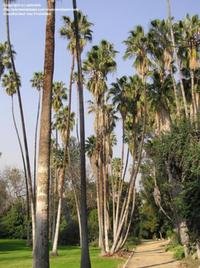
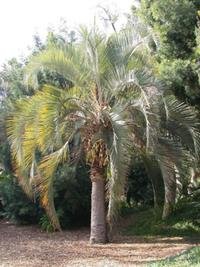
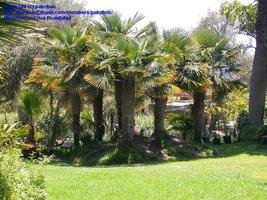
Well known cold hardy palms: Washingtonia robustas, Butia capitata and Trachycarpus fortuneis
Archontophoenix myolensis may at first look just like another King Palm, but it's not. It has shorter, brighter green leaves, a bright green ringed trunk (while young) and a nearly turquoise crownshaft. It is less cold hardy and slower than a king palm, but still hardy enough to survive most marginal climates if given some protection from frost (eg. grown under canopy). It is usually available from specialty palm sources but for some reason is often looked over when folks go shopping for rare palms. This palm will easily make a garden look more tropical, and planting them in small colonies creates an unsurpassed ornamental effect.
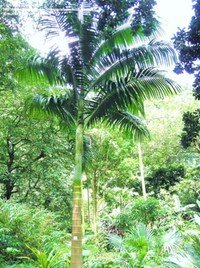 Archontophoenix myolensis in Hawaii
Archontophoenix myolensis in Hawaii
Brahea pimo is not just one of the other Braheas... this is a rare species that periodically can be found at palm specialty nurseries and is one of the most beautiful of the genus. It is a small, solitary fan palm that is very slow growing, but has wonderfully fuzzy leaves and some reddish-pink colors on the petioles. An old palm will be 6'-8' tall- it will rarely outgrow its location. Cold hardiness is probably less than some other Braheas, but still probably not an issue in zones 9b-10a. If you see this one for sale, don't pass it up!
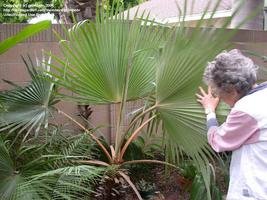
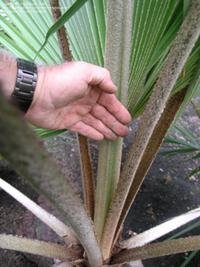 Brahea pimo and close up of petioles
Brahea pimo and close up of petioles
Chamaedorea adscendens is one of the easiest yet least grown of the genus and makes a fantastic potted plant as well as a great understory plant for shady gardens. It only grows to 2' tall or so, but has large, thick leathery pinnate leaves and ovoid leaflets with some attractive bloom on the undersides of the leaves. It seems pretty cold hardy, at least relative to most Chamaedoreas, tolerating temps down to 26F without any damage. This one also seems to tolerate some direct sunlight and hot weather.
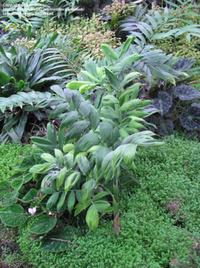
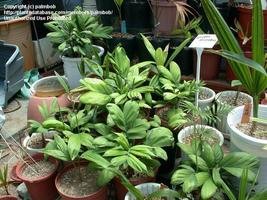
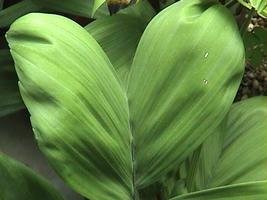
Chamaedorea adscendens in southern California, grown in pots, and close up of leaf (last photo by Chris Mankey)
Chamaedorea oreophila- this is a super hardy Chamaedorea, though there are hardier ones. It is a solitary stemmed species with a moderate rate of growth and looks vaguely like Chamaedorea elegans (Parlor Palm), but faster growing and more cold hardy. Use as an indoor plant has not been explored anywhere near as much as it has with Chamaedorea elegans, one of the best indoor palms there are, but it should do well as one if given sufficient light. This is one of the easiest outdoor palms to grow and if grown in colonies, one will often have luck with successful pollination and the plants will reward you with some of the most brilliantly colored chains of red fruits. It can handle some sunlight, but not hot, afternoon direct sun. Cold tolerance is down to at least 25F and perhaps lower.
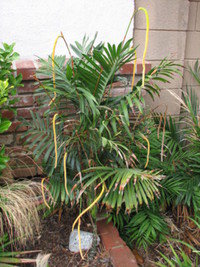
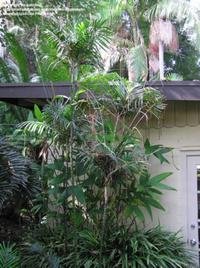
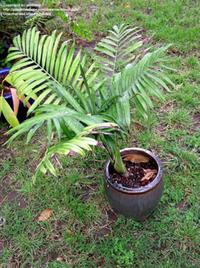
Chamaedorea oreophilas- in my own garden, in private garden (old plants), and as potted plant
Chuniophoenix nana- this is an under-utililized and surprisingly easy and hardy palm for many different climates, from tropical to cool subtropical. It is from tropical areas of China and Viet Nam, yet it has amazing hardiness for such an origin. It's true cold hardiness has really not been well tested yet, but temps down to about 25F did not phase it in the least. This is a small, neat suckering fan palm similar in appearance to a Rhapis excelsa (Lady Palm). It is a slow to moderate grower, somewhat faster than the similar looking Rhapis, but less invasive and a bit more elegant looking. It can handle some direct sunlight, but again, not hot, dry afternoon sun. This one also might be a good house plant, but not much information exists yet about its use as one.
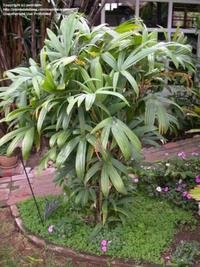
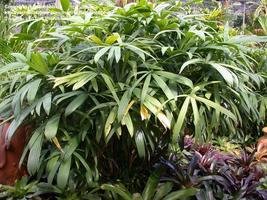
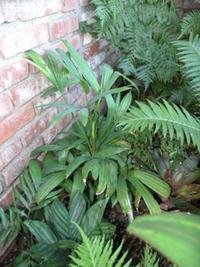
Chuniophoenix nana grown in southern California, in the tropics, and last photo is of my own plant
Cyphophoenix elegans- not known as a fast palm, it is now grown frequently enough by palm specialty nurseries that one can obtain larger plants instead of waiting decades for this to develop into a nice tree (it will cost you, though). This New Caledonian species is one of the hardiest and most trouble-free of all the New Caledonia species. This is a classic crownshafted feather (pinnate) palm. It tolerates more sun than the other species but still prefers afternoon sun protection. This species will eventually get tall unlike the others discussed so far, but it will take decades to get there. It has one of the most elegant and ornamental silhouettes of any palm species.
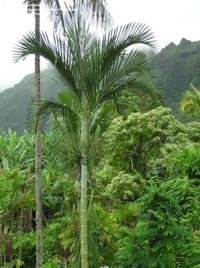
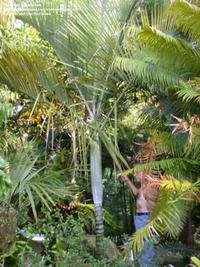 Cyphophoenix elegans in Hawaii, and maturing in California
Cyphophoenix elegans in Hawaii, and maturing in California
Dypsis saint-lucei- there are lots of great Dypsis species, some extremely marginal and some fairly hardy, but this species is one of the most reliable and cold tolerant of the genus, as well as being one of the most ornamental. It was not readily available until recently, but now one can get these easily from Hawaii at a very reasonable cost. They are fairly slow growing solitary feather palms with nearly pure white crown shafts and elegantly arching leaves. Mature palms are still rare outside of Madagascar, but one can see excellent maturing palms in Hawaii now, and in another 10 years, in the Mediterranean climates about the world. It is hardy to down to about 25F or maybe lower.

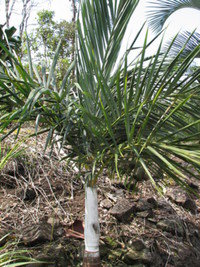
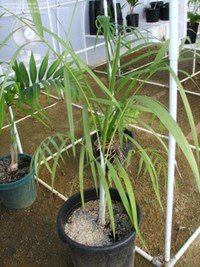
Dypsis saint-lucei mature palm in southern California, maturing in Hawaii, and seedling ready to be planted
Hedyscepe canterburyana (Umbrella Palm)- this is one of the few palms on this list common enough to have a common name, yet it is still a very underutilized plant. This is a moderately slow palm, but adult palms can be grown in just 10 years from seed, and one will be rewarded with one of the most beautiful palms that can be grown in southern California- markedly ringed palm with a large, glaucous crownshaft and exaggeratedly recurved leaves that give the palm its common name. This is one of three good palms to grow from the small Lord Howe Island off the coast of Australia. It is only cold hardy down to about 28F, but if grown under some canopy it will not be hard to get it through some tough winters.
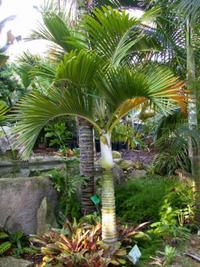
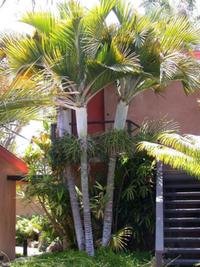

Mature Hedyscepe canterburyanas in private gardens, and last photo is of seedlings for sale
Hyphaene coriacea (Doum Palm)- this is another way-underused palm that is great for most marginal climates, be they Mediterranean, humid or desert- the more heat the better. It grows fairly slowly along the coast where it rarely gets hot enough, but inland it does pretty well as long as it's protected from severe frosts. It will burn at temps below 27F, but will often recover as it is a suckering fan palm. The leaves are an ornamental pale blue-green to grey-green and costapalmate (arching palmate with a midrib). The petioles are a striking black with oranges, yellows and turquoises. This is one of the few branching palms, though in most climates, the branching only occurs at ground level.

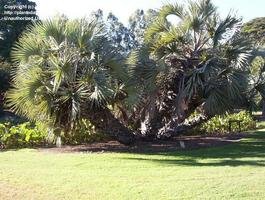
Maturing Hyphaenes above (second photo by klaude) and two shots of seedlings in southern California below
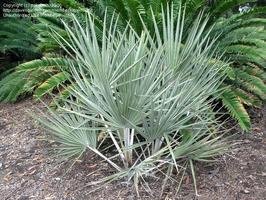
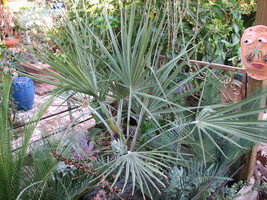
Livistona fulva- actually, most of the Livistonas are great palms for marginal areas (a few are too tropical or picky), but Livistona fulva is one of less common ones, but still easy and highly ornamental. This is a moderately fast growing solitary fan palm with stiff palmate leaves that do not droop at the tips as so many other Livistonas do. Additionally the undersides of this species have an attractive rust-colored bloom that is particularly striking in the setting sun. This is one of the more elegant Livistonas and always gets comments from observers.
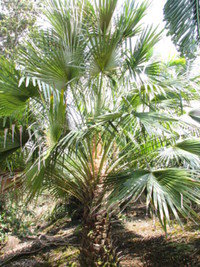
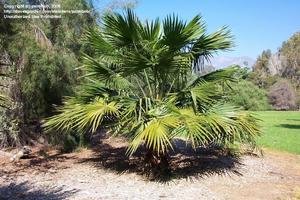
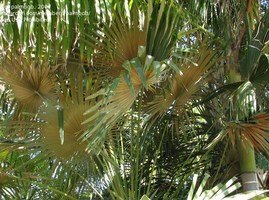
Livistona fulva maturing in Hawaii younger palm in Los Angeles shot of rust color on undersides of leaves
Lytocaryum weddellianum- this is one of the most under used understory palms for the more shady gardens in marginal climates. It is a relatively fast grower in terms of making leaves, but its miniature stature makes it a slow grower overall. This Brazilian native is closely related to the Queen palm, but is a super miniature that grows well in low light situations (might even do well as an indoor palm?) with very fine, lacy pinnate leaves and a thin trunk less then 1" in diameter. It grows eventually up to about 10' tall, but takes several decades to get there. Lytocaryum hoehnei is another great palm, but still pretty rare.
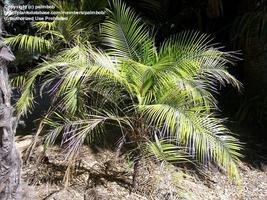
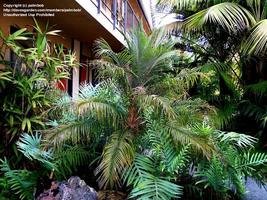
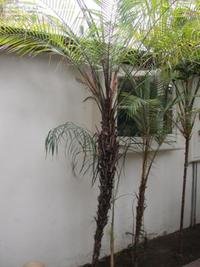
Lytocaryum weddellianaum in a lot of sun same species grown a mostly shaded environment old palm about 8' tall
Parajubaea sunkha- this is probably the best full-sun rare palm for Mediterranean climates and is finally becoming available in large numbers. It is a crown-shaftless feather palm with thin, whispy leaflets that have a silvery to coppery underside. Growth rate is exceptional once it gets going and it rivals some of the fastest palms that grow in non-tropical climates (NOT a good palm for humid or tropical climates!). It also has exceptional wind and heat tolerance as well as just about anything that comes along other than severe frost (hardy down to about 26F). It is still an expensive palm thanks to unpredictable seed germination and rarity. But in another 20 years I predict this will be a commonly grown palm in southern California and even an excellent choice for commercial landscaping. It is not at tall as it's ‘big brother' Parajubaea torralyi, but it is a more predictable and reliable plant, less apt to suddenly die or have bud rot than the other two species of Parajubaea. Still, Parajubaea torallyi is also a great plant for southern California, and some taxonomists consider Parajubaea sunkha to be a variety of it.
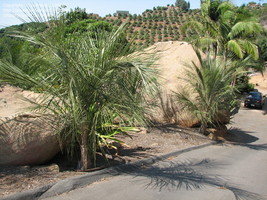
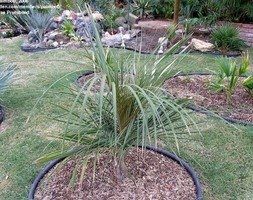
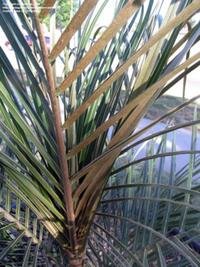
Parajubaea sunkhas in inland southern California seedling in my yard showing some coppery color
Rarely does one seek out a rattan palm when one is thinking about good palms to grow in the yard in a marginal climate, but Plectocomia himalayana is one of the best rattans there is for ornamental landscaping. It is a spiny palm, which is not always growers favorite things, but it is the most cold hardy and ornamental of all the rattans, and it also a fast growing palm. It has a markedly ringed trunk with closely spaced spines, and long, arching pinnate leaves with ovoid leaflets. This is a scary palm to grow in a tropical climate as it becomes a giant, spreading monster in just a few years, often requiring professional removal. But this palm is not a problem species in California. It appears to be hardy down into the high 20s.
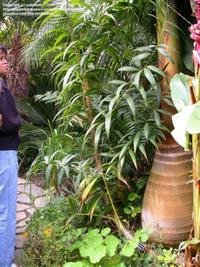
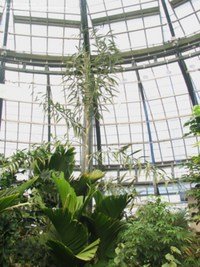
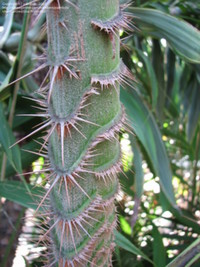
Plectocomia in private garden rapidly growing plant in conservatory close up of spination
Ravenea glauca is one of the best two obtainable Raveneas for southern California- it is a slightly diminutive version of the Majesty palm but with less problems of yellowing and bud rot. It is a solitary pinnate palm with thin, closely spaced, slightly glaucous leaflets and a 6"-8" thick crown-shaftless trunk. This is a moderate grower, but pretty slow from a small seedling- much slower than Ravenea rivularis, the Majesty palm. This palm likes full sun and doesn't yellow from excess heat and sun like Majesty's do (at least when young). Cold tolerance is about the same for both (27F) though both palms have a good track record of recovery even if their spikes pull out following a freeze.
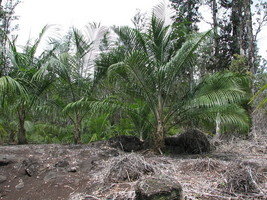
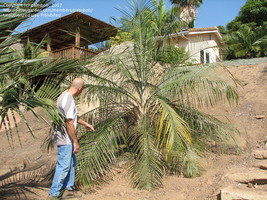
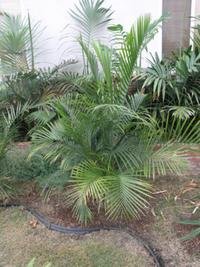
Colony of Ravenea glaucas in Hawaii seeding female palm in southern California my seedlings last year (only one left after frost)
Ravenea xerophila is probably the most cold hardy of the Raveneas and a unique looking palm. This plant is remarkably slow, but a reliable grower once it obtains some size (grow this one up in a greenhouse to a 5 gal size before planting- will save you many years of waiting). Ravenea xerophila has a root like a cycad (thick and succulent) and stiff, grey to blue-grey arching leaves. It is a great palm for hot, inland climates and seems to suffer a bit in cool coastal weather. It enjoys full sun- the more the better, but only once it has attained a size worthy of a 5 gal container. Dinky seedlings seem to prefer some sun protection. No mature palms of this species exist outside of Madagascar yet, but soon there will be some in warmer gardens throughout the world. It is a marvelous landscape specimen for those who plan to be alive a long time.
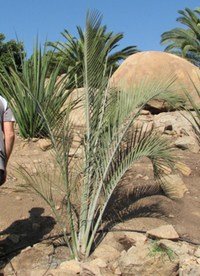
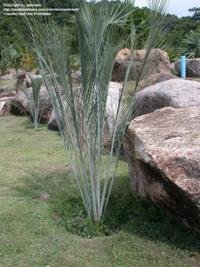
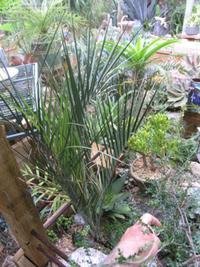
large Ravenea xerophila in southern California growing in rainy tropics my own seedling (10 years old)
Rhapis multifida is the best looking of all the Rhapis species, with fine pointed leaflets of deep green. This is a smaller, suckering fan palm with a close clustering habit. This is not a great full, hot, inland sun palm- best for shady gardens, and makes an excellent indoor palm as well. Cold tolerance is probably about 25F, or maybe a bit colder, but severe frosts rarely kill this one permanently unless the roots freeze as well.
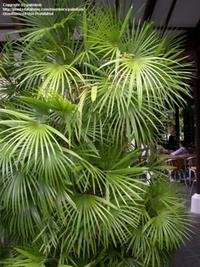
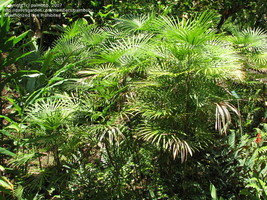
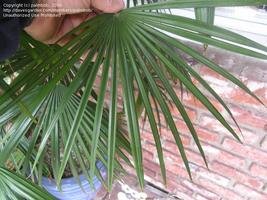
Potted Rhapis multifida plant growing in tropics close up of leaf shape
Rhopalostylis baueri is one of two species of Rhopalostylis from New Zealand and nearby islands. This is a moderately slow growing solitary pinnate palm with a lime green bulbous crownshaft and lots of red/pink and grey in the petioles when young. It is not a great palm for super hot climates, nor a good one for full sun, but one of the premiere palms for a larger garden with lots of tall canopy trees (like Eucalyptus) or against the north side of a taller building. It eventually gets pretty tall (30'), but takes many decades to get there. The leaves are upright and arching like a giant shaving brush and the trunk is very closely ringed. It is a reliable fruiter and the fruits are brilliant and ornamental red color. Cold hardiness is about to 27F. Both Rhopalostylis species and all varieties are worthy of growing in southern California or any Mediterranean climate.
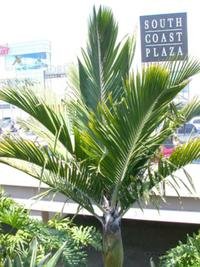
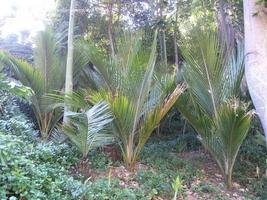
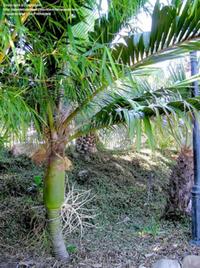
Rhopalostylis baueri crown younger palms growing in San Dieog Zoo crownshaft and flower of maturing palm
Sabal yapa is another relatively under-tried palm and it is a beauty for southern California as long as frosts don't beat it up too badly. It is the least frost tolerant of all the Sabals with damage occurring to the horizontal leaves around 28F-29F. But the overall palm will survive temps down to about 25F or less (just defoliates). This palm is hard to distinguish from Sabal mauritiiformis, another great performer for southern California, but this one seems to grow a bit larger and with more blue on the undersides of the leaves. This palm can be grown in full sun or shade, though it will grow pretty slow in a shady location. It is a massive solitary fan palm with deeply split leaves (unlike most other Sabals) that make it look a bit like a giant Licuala when young.

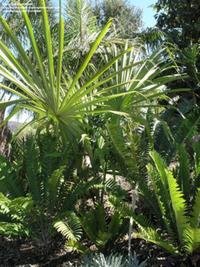
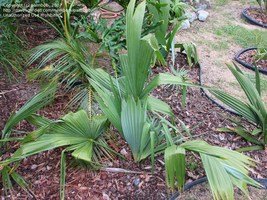
Sabal yapa in Florida (photo Mike Dahme); younger palm in Southern California; My own seedling showing blue undersides of leaves
Syagrus botryophora- though some find this a bit too marginal and slow at first, it develops into a delicate, elegant, solitary pinnate palm with an ornamental thatched trunk and non-plumose, arching short leaves. It looks nothing like a queen palm really, though many other Syagrus can be hard to tell apart. It is a bit intolerant of high winds (looks OK, but tends to blow over) and only cold tolerant down to about 27F. This is one of the most popular ‘new' palms among palm enthusiasts in both marginal as well as tropical climates.
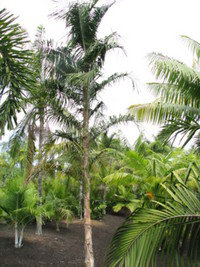
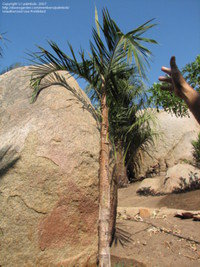
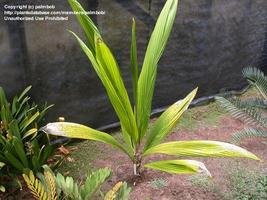
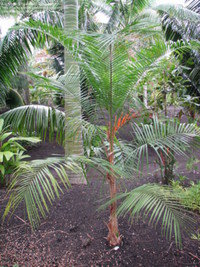
mature Syagrus botryophora in Hawaii maturing palm in southern California look of immature palm young palm, Hawaii
For those who want something interesting and very different, try Wallichia disticha, a tropical Asian solitary pinnate palm that grows in one plane only (distichous). Its cold hardiness is surprising considering its origins, and it is a moderately fast grower. This is another palm sure to illicit comments from onlookers. The only down side with this palm is it is monocarpic (dies after flowering) and is not a particularly long-lived palm. This is one of the few palms one can grow from a seedling with a good chance of seeing it live its entire natural lifespan (15-20 years).
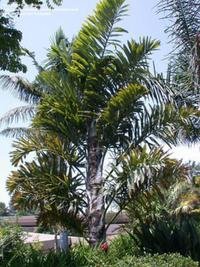
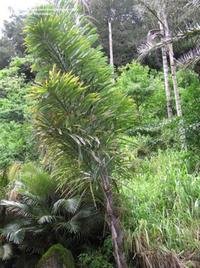
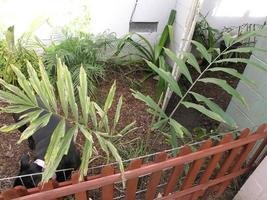
Wallichia disticha 'front view' southern California; 'side view' Hawaii my seedling
I hope this list of palms has given those who have an interest in growing palms in their yard a few ideas on how to make their landscaping unique and tropical. For those who live in desert environments, one of the next articles will be about palms that you should consider growing that do best in your unique climate.
Organic Vegetable Gardening for Beginners - Great Hints and Tips
Blue Fan Palms for the desert landscape- unique trees for both public and private parks and gardens
10 Essential Native Perennials for the Great Lakes and Upper Midwest
Great Design Plant: Blue Vervain for Beauty and Bees
Great Design Plant: Ogon Spirea for Radiance and Texture
Great Design Plant: Thunder and Lightning for Midsummer Garden Color
Copyright © www.100flowers.win Botanic Garden All Rights Reserved